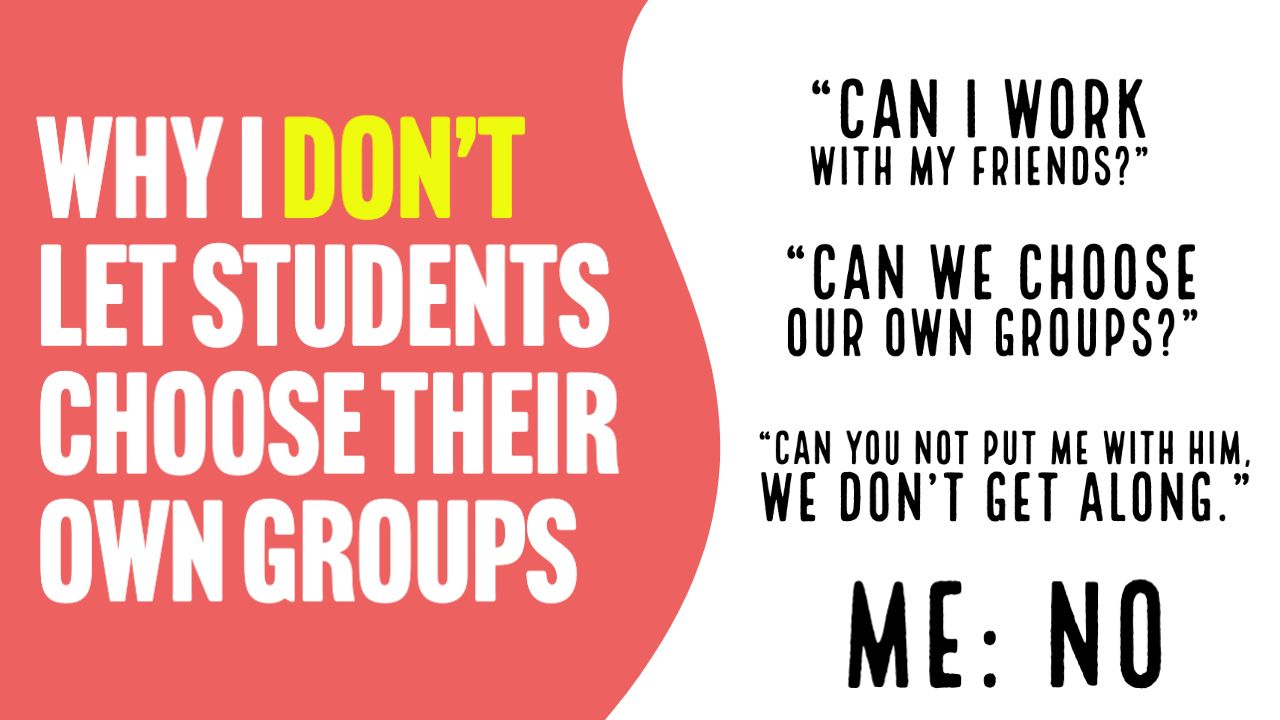
Why I Don't Let Students Choose Their Own Groups
May 08, 2023I’m a strong believer in what I like to call ‘strategic group formation.’ You know what that means?
The teacher chooses groups.
Which historically drives students crazy. Have you heard this line before?
“Teacher, I promise I work so much better when I sit next to her. We’re best friends and get along great.”
Or how about this one?
"Teacher, I don’t get along with him, so we really shouldn’t be in a group together.”
Or how about: "Teacher, can I work with my girlfriend? We work great together?”
Yeah I bet you do.
I’ve heard each of these lines more times than I can count. Whenever there’s been even a hint that students will be working or discussing in groups, there’s an immediate rush to ask if they can choose who they work with. From day one of the school year, students begged and pleaded in utter desperation for me to not use the dreaded seating chart and allow them to sit and work with their friends.
And every time, without exception, no matter how much pleading I heard and despite how well the students crafted their arguments, regardless if they have demonstrated the collaborative skills of honeybees and focus and diligence of brain surgeons, my answer has always been the same: NO!
Why Students Don’t Get to Choose Their Groups
Ok, I occasionally budge on this and give some choice, but the truth is, I rarely allow students, even my fourth-year college students, choose where they sit in the classroom during collaborative work. They often assume I’m a crotchety old teacher bent on using my power to make their lives miserable by not letting them sit with their friends.
Understandable.
But what students often don’t understand, even though I’ve explained it on day-one of each school year, is that assigned seating in my classrooms is not a punishment. I don’t choose collaborative groups as a result of bad behavior, nor just as a preventative of it. I don’t assign seats to make taking attendance easier (although it definitely helps) or to make it less complicated passing back school work. My mission isn’t to separate friends from each other so that they won’t talk during class.
I actually assign seats so that students will talk in class.
Let me explain.
1. Strategic group formation leads to better discussions.
When I used to allow students to choose their groups, they naturally always found their friends or close acquaintances, the people they are comfortable with. The result was they either were too distracted by their friends to have a meaningful discussion, or because they felt so comfortable, discussion came too easy. Which is great in some ways, of course. I want students to feel comfortable and to discuss more. But when things come easy we fail to grow nearly as much. Ample research shows that the best growth happens outside of our comfort zone. When we are not challenged, our brains largely remain stagnant in terms of new growth. So while the discussion may be good, student-growth may not be, and students need growth in discussion skills, especially with people they are less comfortable with. Here’s why:
2. Selecting your own groups is not realistic
The reality is, you don't get to choose your groups most of the time throughout your career. Unless you're the business owner and hire all of your friends (which might not be the best idea), you don't really choose who you work with. Did you choose the educators you work alongside of, or did you get hired into your school and you had to learn to work with your teammates without really knowing any of them?
The truth is, we're not necessarily best friends with the people we work with, which is perfectly okay, you don't have to be. Hopefully you like them, but friendship is not a requisite for having a successful team. However, the expectation is that you will discover how to be successful with people from different backgrounds, religions, races, likes and interests, etc. Not knowing someone, or even liking them, is not a viable excuse for failing at a professional task. School needs to be a place where students learn to do this, but it can really only happen if we choose the groups.
3. Strategic group formation increases productivity.
The other advantage of strategic group formation is the productivity that happens when you use strategy to form groups (hence the name). Sometimes there are students who don't work well together and it becomes a distraction to the rest of the class. It might make sense to place them in separate groups.
Maybe you have a student who has shown over and over that they are a leader and a really strong person to have in a group. This student might need to be strategically placed with someone who needs a little extra help.
Perhaps there's a group of students who continue to slack throughout projects and just keep riding on their teammates’ coattails. Maybe for one project those students need to be placed together and see what it's like when there is no coattail to ride on.
Or maybe you have students who keep hogging all the work, and they need to be placed together to see what it's like to work with someone who can be overbearing.
The point is, educators have a unique perspective of their classroom and the social dynamics, and we can use that perspective to form effective groups.
The Power of Working With New People
And when students begin to thrive with new people in different settings, hopefully they will see the value of group assignments. They’ll learn that they are capable of working with people they are not yet close with and can discover that they can even succeed with people they don’t like. When their teacher chooses groups with intentionality and purpose, they’re equipping students with a capability they will use throughout their lives as they enter college groups and workplaces where they will have little say about who they collaborate with. And hopefully because of this, students will not think you are a crotchety old teacher bent on using your power to make their lives miserable by not letting them sit with their friends. But even if they do, they’ll still get better at collaboration.
So there's the 'why,' but what about 'how' to form effective groups? I share a bunch of strategies on how to form the most effective groups in my book, The Collaborative Classroom. You can check it out here.

Stay Connected With Trevor's Work
Join thousands of educators who receive weekly articles, videos, and inspiration from Trevor.
SPAM is the worst. I promise to only send you my best stuff and NEVER to share your email.
